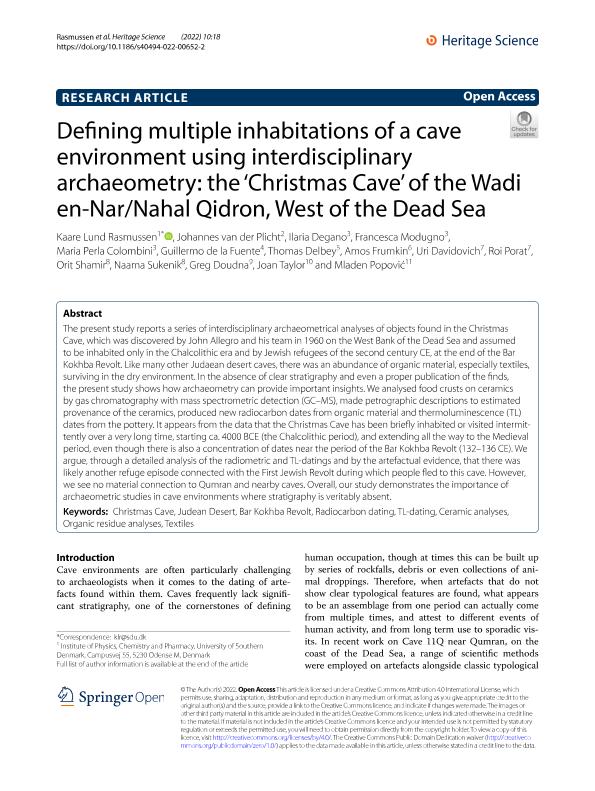Artículo
Defining multiple inhabitations of a cave environment using interdisciplinary archaeometry: the ‘Christmas Cave’ of the Wadi en-Nar/Nahal Qidron, West of the Dead Sea
Rasmussen, Kaare Lund; van der Plicht, Johannes; Degano, Ilaria; Modugno, Francesca; Colombini, Maria Perla; de la Fuente, Guillermo Adrian ; Delbey, Thomas; Frumkin, Amos; Davidovich, Uri; Porat, Roi; Shamir, Orit; Sukenik, Naama; Doudna, Greg; Taylor, Joan; Popović, Mladen
; Delbey, Thomas; Frumkin, Amos; Davidovich, Uri; Porat, Roi; Shamir, Orit; Sukenik, Naama; Doudna, Greg; Taylor, Joan; Popović, Mladen
 ; Delbey, Thomas; Frumkin, Amos; Davidovich, Uri; Porat, Roi; Shamir, Orit; Sukenik, Naama; Doudna, Greg; Taylor, Joan; Popović, Mladen
; Delbey, Thomas; Frumkin, Amos; Davidovich, Uri; Porat, Roi; Shamir, Orit; Sukenik, Naama; Doudna, Greg; Taylor, Joan; Popović, Mladen
Fecha de publicación:
02/2022
Editorial:
Springer
Revista:
Heritage Science
e-ISSN:
2050-7445
Idioma:
Inglés
Tipo de recurso:
Artículo publicado
Clasificación temática:
Resumen
The present study reports a series of interdisciplinary archaeometrical analyses of objects found in the Christmas Cave, which was discovered by John Allegro and his team in 1960 on the West Bank of the Dead Sea and assumed to be inhabited only in the Chalcolithic era and by Jewish refugees of the second century CE, at the end of the Bar Kokhba Revolt. Like many other Judaean desert caves, there was an abundance of organic material, especially textiles, surviving in the dry environment. In the absence of clear stratigraphy and even a proper publication of the finds, the present study shows how archaeometry can provide important insights. We analysed food crusts on ceramics by gas chromatography with mass spectrometric detection (GC–MS), made petrographic descriptions to estimated provenance of the ceramics, produced new radiocarbon dates from organic material and thermoluminescence (TL) dates from the pottery. It appears from the data that the Christmas Cave has been briefly inhabited or visited intermittently over a very long time, starting ca. 4000 BCE (the Chalcolithic period), and extending all the way to the Medieval period, even though there is also a concentration of dates near the period of the Bar Kokhba Revolt (132–136 CE). We argue, through a detailed analysis of the radiometric and TL-datings and by the artefactual evidence, that there was likely another refuge episode connected with the First Jewish Revolt during which people fled to this cave. However, we see no material connection to Qumran and nearby caves. Overall, our study demonstrates the importance of archaeometric studies in cave environments where stratigraphy is veritably absent.
Archivos asociados
Licencia
Identificadores
Colecciones
Articulos (IRES)
Articulos de INSTITUTO REGIONAL DE ESTUDIOS SOCIO-CULTURALES
Articulos de INSTITUTO REGIONAL DE ESTUDIOS SOCIO-CULTURALES
Citación
Rasmussen, Kaare Lund; van der Plicht, Johannes; Degano, Ilaria; Modugno, Francesca; Colombini, Maria Perla; et al.; Defining multiple inhabitations of a cave environment using interdisciplinary archaeometry: the ‘Christmas Cave’ of the Wadi en-Nar/Nahal Qidron, West of the Dead Sea; Springer; Heritage Science; 10; 1; 2-2022; 1-22
Compartir
Altmétricas



